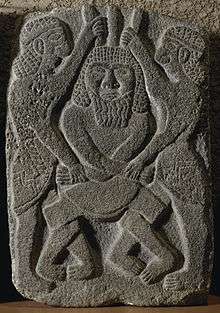Kapara
King Kapara (also Gabara) of Guzana (Tell Halaf) was the ruler of Bit Bahiani, a small Hittite kingdom[1], in the 10th or 9th century BC (Albright 1956 estimates ca. 950-875 BC). He built Bit-hilani, a monumental palace in Neo-Hittite style discovered by Max von Oppenheim in 1911, with a rich decoration of statues and relief orthostats.
In 894 BC, the Assyrian king Adad-nirari II recorded the site in his archives as a tributary Aramaean city-state. In 808 BC the city and its surrounding area was reduced to a province of the Neo-Assyrian Empire.

This relief carving was found at the temple-palace of Guzana. It depicts two heroes subduing a foe. Walters Art Museum, Baltimore.
References
- ↑ Anatolian Studies, Volumes 5-6. British Institute of Archaeology at Ankara. 1955. p. 82.
- W. F. Albright, The Date of the Kapara Period at Gozan (Tell Halaf), Anatolian Studies, (1956).
External links
This article is issued from
Wikipedia.
The text is licensed under Creative Commons - Attribution - Sharealike.
Additional terms may apply for the media files.